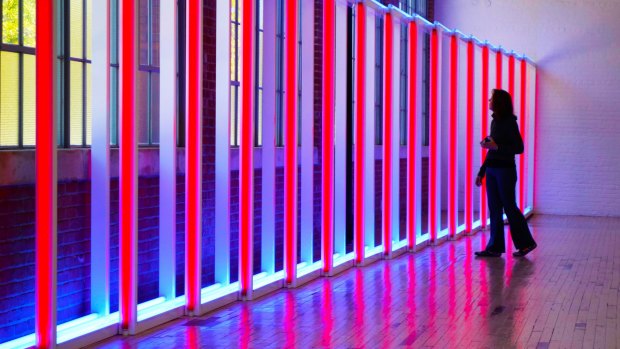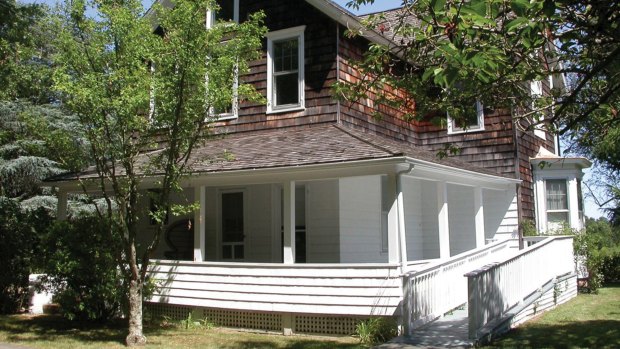This was published 4 years ago
Why artists flock to the Hamptons, on the East End of Long Island

The East End of Long Island is adored by artists, who come for the ethereal light.Credit: Alamy
The East End of Long Island is home to the Hamptons, a phrase that conjures images of tanned people in polo shirts clutching tennis rackets and tall glasses of gin. It's an accurate image, particularly in the warmer months – but it is not the complete picture.
East End is also – as the late great Robert Hughes once pointed out – "an encyclopedic museum of marine habitats". It is an Eden for birds, migrating down the coast to South America. And it is adored by artists, who come for the ethereal light. As early as the 1870s, painters such as Winslow Homer travelled from New York to feel inspired and, in the 1890s, thousands of students flocked to Long Island to paint en plein air at the Shinnecock Hills Summer School of Art. A little later abstract expressionists Marcel Duchamp and Max Ernst made it their playground.
Artists and uber-wealthy holidaymakers: the contrast between these two social groups has been a subject of local amusement for almost a century. The artists "are aware of cashmere-sweatered golfers putting nearby, but they ignore them", Patty Southgate observed in 1959. "The golfers, in turn, sense that something suspicious is being done with paint right down the road, and putt on."

This 1879 homestead is the former residence of abstract expressionist painters Jackson Pollock and Lee Krasner.
Wanting to explore the artistic side of the East End, I recently drove out to take in the galleries and museums. The Dan Flavin Art Institute, for example, is a renovated firehouse in Bridgehampton dedicated to Flavin's unusual work with fluorescent lights; the artist originally conceived the space as a single installation. In East Hampton, Guild Hall has been hosting local artists for as long as anybody can remember. But I start in the Springs, which is about 10-minutes away from East Hampton on the "wrong side of the tracks" – literally. The Long Island Railroad slices the area into two different socio-economic pieces.
Jackson Pollock moved to Springs in 1945, when it was still open fields and patches of scrub oak and modest cottages owned by Bonackers, the name for local fishermen. With his wife, Lee Krasner, also a painter, they bought a house for $5000 overlooking Accabonac Creek. The house had no heating; Pollock couldn't afford it. He would not become famous until a few years later, when a Life magazine article touted him as "the greatest living painter in the United States".
Remnants of the paintings for which Pollock became legendary – his "poured" works – can be seen on an excellent guided tour that takes in the house and studio. Beginning under a capacious swamp oak overlooking the creek, our guide leads us into the converted barn where Pollock created most of his works. The room is perfect for an artist, high and bright, and all over the floor are splatters of paint; Pollock would lay his canvases down and drip paint onto them, using his whole body to create a sense of force and movement. The art critic Harold Rosenberg would describe them as "action paintings", paintings that recorded their own physical act of creation.
Krasner worked in the house, which feels as though it is still being lived in. Nothing has been moved since she died in 1984: their rocking chairs, books, shells, and twin beds are exactly where she left them. As the guide shows us each room, the effect is eerie: we are gawkers who have broken in while the owners are out buying milk. I half expect Krasner to walk in and throw a fit.
Pollock, of course, died before her in 1956, wrapping his car around a tree just down the road. He was drunk and angry and possibly suicidal, which made an unfortunate combination for the two women riding with him (one of whom also died in the crash). Pollock's grave – a point of pilgrimage for art lovers – is marked by a large granite boulder in the nearby Green River Cemetery. Krasner is buried alongside him beneath a smaller boulder.
Because they are worth a fortune, none of Pollock's paintings are held at the Pollock-Krasner House and Study Centre. But I find one of Krasner's canvases in the Parrish Art Museum, a few towns away in Water Mill. Indeed, the Parrish offers a terrific overview of the abstract expressionists. It also explains the art scene in the East End, connecting it with the landscape in fascinating ways. Founded in 1898 as a single exhibition hall in Southhampton – Samuel Parrish wanted to show off his private collection – it was relocated in 2012 to a monumental building that is an artwork in its own right.
Designed by architecture firm Herzog and de Meuron, the Parrish looks like a high-tech barn for giant horses. All concrete and glass, it is marked on the highway by a garish Roy Lichtenstein sculpture, and graceful reeds surround it in an open field, recalling the days when this was farmland. The galleries are lovely. A room of paintings by Fairfield Porter, a prominent local painter from the mid-20th century, sits next to others filled with canvases by David Salle, William Merritt and Willem de Kooning – another iconic local.
To visit the Parrish is to see the East End anew, through the eyes of some of America's most esteemed artists. I pass hours here, revelling in the art, my eye drifting only occasionally to the traffic jam outside. The jam started in May, and the common sentiment seems to be that it will remained jammed until sometime in late October, when the crowds disperse.
An unexpected companion to the museum can be found in the Northwest Woods, hidden behind a line of high, expensive trees. LongHouse Reserve, a almost seven-hectare private estate founded by noted textile designer Jack Lenor Larson, is surely one of the most beautiful gardens in the country – not to mention its unrivalled sculpture collection. Since Larson bought the place in 1970, he has worked to create something extraordinary out of hemlock hedges and cyrptomerias and a house inspired by a seventh century Shinto shrine.
But it the art people come to see and, upon arriving, a volunteer thrusts a map into my hand that looks on the page like a very green Disneyland. Similar to David Walsh with MoMA, Larson has integrated the art with the environment into a cohesive whole. A towering red rose by Will Ryman has metal petals strewn through the undergrowth. A fly's eye dome by Buckminster Fuller squats in the grass like an alien spaceship. Sometimes – as with Larsen's own "Study in Heightened Perspective", bursting with flowers – it is not entirely clear what is art and what is just good garden design.
LongHouse is gorgeous. It is also astonishingly little known to the outside world. It was only through an offhand comment from somebody that I learned about it at all. But that is the nature of art in the East End: with so much emphasis on the wealth and glamour, on the Lexus cars and Blade helicopters – on "the Hamptons" and all its attendant pomp – the most impressive side of the area gets overlooked entirely. Or it gets deliberately ignored, just as Patsy Southgate once observed, as the golfers putt on, rushing their way to the nineteenth hole.
TRIP NOTES
FLY
Qantas offers daily flights to the US with connections to New York (see qantas.com). From New York City, the East End of Long Island is a two to three-hour drive, or ride the Long Island Railroad, or take the Jitney bus (see hamptonsjitney.com).
ART
The strange Dan Flavin Art Institute, operated by Dia, is located on Corwith Avenue in Bridgehampton. Hours vary, though admission is always free; see diaart.org.
The Pollock-Krasner House and Study Center is open May to October. Book ahead for tours ($US15); self-guided tours are available on Saturday afternoons ($US10); see stonybrook.edu/pkhouse.
The Parrish Art Museum is open every day except Tuesday ($US12); see parrishart.com.
Gardens at the Long House Reserve are open Wednesday and Saturday afternoons only. Admission is US$15 per person; see longhouse.org.
Other East End galleries of note are East End Arts (eastendarts.org), the Eric Firestone Gallery (ericfirestonegallery.com), and the Madoo Conservancy in Sagaponack (madoo.org).
Sign up for the Traveller Deals newsletter
Get exclusive travel deals delivered straight to your inbox. Sign up now.